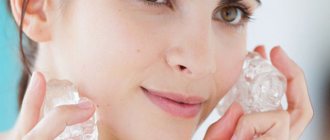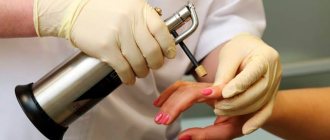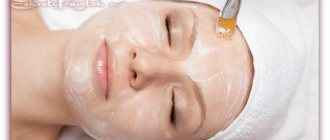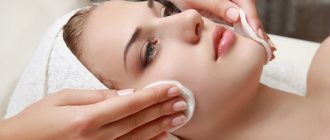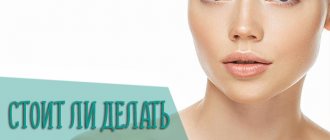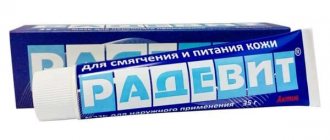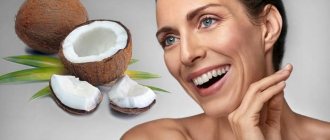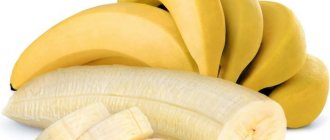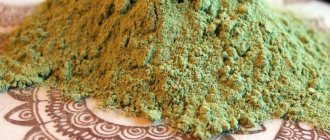Today, a very popular salon procedure is cryotherapy for the face - cold treatment of the skin. It will be useful for both young girls with some kind of cosmetic imperfections and mature ladies of Balzac’s age with obvious signs of aging to find out what it is, to whom it can be prescribed or recommended, and whether it is worth spending money on it. In fact, the effectiveness of this method allows you to solve many appearance problems without surgery or any other drastic measures. So let's get to know him better.
Cryomassage of the face. Features, indications and contraindications
Facial cryomassage is an easy and pleasant procedure that is highly effective.
The procedure has a number of features. Firstly, facial cleansing with liquid nitrogen improves blood circulation (and therefore nutrition) in the skin, which promotes the healing of all inflammatory processes. Secondly, facial massage with liquid nitrogen gives a slight peeling. Along with the cold, dead skin cells are sloughed off.
Facial cryomassage with liquid nitrogen is contraindicated:
- People with thin skin and nearby blood vessels.
- Patients with skin damage.
- If you have herpes.
Facial treatment with liquid nitrogen is a painless and quick action that has a number of indications:
- Loss of facial skin elasticity.
- The appearance of small wrinkles on the skin.
- Treatment of acne and pimples.
- When the secretion of the sebaceous glands of the face is impaired (too oily skin).
- If you have enlarged facial pores.
- To remove freckles or age spots.
- When it is necessary to relieve facial swelling.
- Before or after facial cleansing.
Cryomassage of the face with liquid nitrogen is also indicated in the presence of extensive loss of scalp hair.
The meaning of cryotherapy for the face
Aesthetic and cosmetic skin imperfections are mostly the result of stagnation. Blue circles under the eyes and spots after acne are the result of sluggish blood circulation, as well as premature weakening of skin turgor, swelling, and scars.
The low temperature of liquid nitrogen acts as a vascular stimulant. When exposed to extreme cold, they contract and then, when exposed to room temperature, expand. Blood flow increases, metabolic processes in the cells of the dermis become more intense, the cells are renewed and saturated with oxygen. Tissue regeneration accelerates. Therefore, facial cryotherapy is recommended to prevent signs of aging or as a maintenance procedure, in combination with other anti-aging therapy measures.
Cryomassage procedure
During cryomassage, the skin on the face is treated with frozen liquid nitrogen. For this, a special applicator is used - a wooden stick with a cotton swab (“reed”). It is dipped into a kind of thermos with liquid nitrogen and applied along the massage lines in thin layers.
The cosmetologist is required to be extremely careful: you need to carefully bypass all sensitive areas (skin under the eyes, lips, etc.). The manipulation takes on average from 10 to 20 minutes, depending on the direction of the massage and the condition of the patient’s skin.
Unlike deep cryotherapy aimed at destroying moles, warts, papillomas, in which the applicator is directly fixed on the neoplasm and held with slight pressure, cryomassage does not involve this. Manipulations are carried out along massage lines or pointwise (for problem skin) for the required areas.
The procedure involves only a light massage of the skin, and not rubbing in liquid nitrogen. During cryotherapy, patients always feel a burning sensation. However, remember: if the burning becomes severe, you need to immediately tell the cosmetologist about it to avoid injury to the skin.
Cold has an effect on the nerve endings of the skin, thus improving the biochemical interaction between cells and blood flow: a sharp narrowing of blood vessels occurs, and then a gradual expansion. Thanks to this, blood flow into the layers of the skin improves, metabolic processes improve, and dead skin particles exfoliate.
Video
Variety of cryoprocedures
Local facial cryotherapy can be presented in the price lists of beauty salons with the following procedures:
- Cryomassage is the effect of liquid nitrogen on the skin for a short period of time using a wooden stick or a cotton swab. Goes well with masks.
- Cryodestruction is local freezing of the deep layers of the skin, leading to complete tissue death. Removes warts, nevi, papillomas and other benign growths on the face.
- Cryodermabrasion is the removal of the top layer of skin on the face using cold. Removes post-acne, stretch marks, scars.
- Cryoelectrophoresis is the introduction of frozen medicinal preparations into the deep layers of the dermis using a pulsating low-intensity current. Eliminates wrinkles, improves color, elasticity, skin turgor, treats acne, seborrhea, eliminates fat deposits on the face.
- Aerocryotherapy - blowing cold air onto the face. Recommended after laser resurfacing, plastic surgery, chemical peeling to relieve pain, swelling, and inflammatory reactions.
- Cryolipolysis is the removal of fat deposits on the face without negative effects on surrounding tissues (nerves, skin, muscles, blood vessels).
All these cryoprocedures have long been actively used in cosmetology to eliminate defects and imperfections on the face and to slow down the aging process. What kind of effectiveness can you expect after visiting the salon? Will the money spent be worth it?
With the world - one by one. Do you know why women living in temperate latitudes look younger and better than their peers in hot countries? It's all about the climate. After all, it is low temperatures that make it possible to stop the aging process.
Cryomassage of the head. Indications and contraindications
Cryomassage of the scalp is indicated for:
- For baldness.
- Slow hair growth on the head.
- Poor hair condition (lack of shine, split ends, thinness).
- Oily and dry scalp.
- When itching and dandruff are present.
When performing a head massage, the hair is first combed and divided into several parts for ease of processing.
Cryomassage of the head is an absolutely painless process. The procedure is contraindicated only for people with individual intolerance to cold.
Cryomassage with liquid nitrogen is a universal procedure. It can be combined with any type of cosmetic care: masks, cleansing, peeling. Massage is very useful, pleasant, takes little time and is inexpensive.
For or against? ^
Like any other procedure, cryomassage with liquid nitrogen has its pros and cons, as well as contraindications. The clear advantages of this procedure are:
- A short recovery period, which allows you to undergo the procedure several times a week.
- Ideal for those for whom mesotherapy is contraindicated and during periods of active insolation.
- Liquid nitrogen does not cause pigmentation ; a big plus is that during the procedure there is no contact with the skin, which leads to the absence of injury to the skin.
- Cryomassage can be combined with other cosmetic and health procedures.
Among the disadvantages of this procedure are redness and some swelling during the day after cryomassage, a feeling of cold and tingling of the skin, which is not always pleasant for the patient.
You can read everything about aromatherapy, its effect on health and, in particular, how good aromatherapy is for colds here.
What to do if you suddenly find it difficult to breathe? You can read about this in this article, save your health!
You can read what a natural air freshener is in this article: https://about-air.ru/svojstva-vozduha/zapahi/osvezhitel-vozduha-dlya-doma.html. How to choose?
Efficiency and safety of cryotherapy sessions
With the correct procedure technique, damage to healthy cells does not occur.
The peculiarity of the effect of abnormally low temperatures on damaged areas of the face is that atypical cells die. This happens because under the influence of cold, intracellular fluid freezes in the dermis.
Diseased cells are destroyed by the ice formed in them. And the blood stops feeding the tissues of the inflamed areas, which also leads to their necrosis.
As a result, the cold treatment method for facial skin has a number of advantages:
- Cold relieves pain while injecting medications under the skin.
- After removing the formations and acne, there are no scars left.
- The result of a competently performed tumor removal procedure will be the absence of relapses.
- Renewed tissues are fully supplied with oxygen and nutrition, which leads to rapid cell regeneration.
- The professional performing the cosmetic procedure varies the treatment levels precisely.
- High efficiency of treatment is combined with speed of therapy.
The safety of the cosmetic procedure is quite high, because when exposed to cold, nearby areas of the face are not affected and the restoration of the skin takes place without serious complications.
Features of the procedure
How is the darsonvalization procedure performed? The device generates high-frequency current with high voltage and supplies it to the body. This impulse is used in physiotherapy and treats the following diseases:
- Cardiac ischemia.
- Varicose veins.
- Arthritis and osteochondrosis.
- Insomnia.
- Neurasthenia.
- Dysfunction of the intestines and stomach.
- Gastritis.
- Sinusitis, otitis, pharyngitis.
Darsonval is most widely used in dermatology. This is quite justified, because darsonvalization of the skin is most effective. The electrodes of the device can either be in contact with the surface of the integument or located at a distance from them.
Cryomassage for face
Cryomassage is a massage using cold. For these purposes, liquid nitrogen is used, the temperature of which reaches -196 degrees Celsius, providing an anti-inflammatory and analgesic effect.
Without direct contact of nitrogen with the surface of the body, a painless effect occurs, as a result of which the vessels instantly expand and contract. Processes are launched that cause rejuvenation of the skin : blood flow is normalized, epidermal cells are renewed. After completing the session, a rush of warmth is felt and a slight, non-discomfortable tingling sensation occurs.
History of the procedure
In ancient Egypt, 2.5 thousand years BC, the Egyptians widely used cold compresses to anesthetize fractures, bruises as an anesthetic and to relieve swelling. Evidence of this has been found in history, captured in the ancient papyrus of the healer Smith.
Numerous works of celebrities of those eras speak about the healing effects of cold on the human body: Avicenna, Galen, Hippocrates. The German priest Sebastian Kneipp in the 20th century used the term “cryotherapy”, which translated from Greek means cold, frost. He successfully practiced the cold method as an independent direction in physiotherapy in the treatment of pathologies of the musculoskeletal system.
Professor from Japan Toshimo Yamauchi in 1984 developed a massage technique that includes multiple cryotherapy techniques and proved the positive effect of low temperatures on the treatment of joints and the treatment of benign skin tumors.
Features of the effects of massage
By exposing the skin of the face and head to cold in combination with massage techniques, a therapeutic and cosmetic effect is achieved. Under the influence of low temperatures, blood vessels alternately narrow and dilate, increasing blood flow to the facial skin.
The positive aspects of this method are safety and environmental friendliness , a combination of therapeutic effects with other cosmetic procedures. Positive changes are noticeable after the first cryomassage sessions.
Negative side of the effect: slight redness and slight swelling are possible , which disappear without a trace within a day. After completing the procedure, it is necessary to avoid sun exposure. After each session, a special moisturizing cream is applied. Peeling of the skin is possible; this is a natural reaction of the body to cold.
In practice, several techniques are used:
- Cryomassage of the face with ice cubes - the procedure is successfully performed at home.
- Cryomassage is performed in a beauty salon by a professionally trained specialist. To do this, the cosmetologist uses an applicator - a wooden stick with a cotton swab fixed on it or a special device that supplies liquid nitrogen under high pressure.
Before cryomassage, the patient is carefully examined to identify concomitant diseases, allergic reactions and chronic diseases.
Deep cryomassage during freezing leads to tissue destruction and death. Used to remove papillomas and various types of tumors. The liquid nitrogen applicator is held for 30 seconds over the area being treated.
During normal use there is no contact between the applicator and the skin. During cryotherapy, patients feel discomfort in the form of a burning sensation, but it does not cause much pain - this is normal. If it appears very pronounced, then in order to avoid skin injuries, the procedure must be stopped.
Low temperatures, having an effect on nerve endings, improve biochemical interactions between the bloodstream and cells.
At home
Device "Holod - 01" for facial cryotherapy at home
Today, facial cryotherapy is available not only in salons, but also at home. There are two methods for performing this procedure yourself.
Cryotherapy with ice cubes
You've probably heard about this skin rejuvenation technique. You freeze medicinal infusions of herbs, fruit juices, milk in special molds - wipe your face with cubes of the resulting cosmetic ice in the morning - and enjoy the freshness and beauty of your rested, rejuvenated skin. However, this procedure is unlikely to save you from benign tumors. The second method of home cryotherapy is much more effective in this regard.
Portable device
If salons have professional multifunctional equipment for facial cryotherapy, then the same manufacturers offer women portable (miniature) versions of these devices. They are convenient to use at home, easy to use, and do not require special skills. The electronic display with which they are equipped allows you to see the set temperature (determine it according to the instructions). If you are not sure that everything will go smoothly, watch training videos, read the instruction manual again, and finally, take advice from a professional.
This is the essence of facial cryotherapy - it is an effective, popular, very promising skin treatment for many diseases and defects. Science fiction is gradually entering our real life. It is very pleasant that the changes have affected cosmetology, the main task of which is to prolong youth and beauty. And liquid nitrogen, coupled with low temperatures, actively helps it with this.
March 28, 2021
Darsonvalization of the face. Pros and cons of the procedure
What are the benefits of darsonvalization of the face?
- Bactericidal and bacteriostatic effect on the skin.
- Improving metabolic processes in tissues.
- Elimination of swelling and inflammation.
- Saturation of the skin with oxygen.
- Increased skin elasticity.
Treatment with darsonvalization is indicated in cases of dullness and sagging skin, oily and dry skin, wrinkles, pimples and acne (facial cleansing). The procedure is also used to treat and normalize the functioning of the sebaceous glands.
Darsonvalization of the face is contraindicated if:
- Pregnancy.
- The patient is under 6 years of age.
- For tumors.
- Allergies to electric current.
- Heart diseases.
- Mental illnesses.
- Tuberculosis.
- Epilepsy.
- Poor blood clotting.
The first session of darsonvalization will not give visible results. In order to see it, you need to complete a course of 10 procedures. In this case, treatment should be carried out at intervals of 1–2 days.
If there are pigment spots or a large number of moles on the skin, the patient should consult a doctor before the procedure.
Local darsonvalization can also be used to treat the scalp. The treatment method is the same as for skin treatment, only a different attachment of the device is used.
The concept of cryotherapy, devices for its implementation
Facial cryotherapy is a cosmetic procedure based on exposing the skin to very low temperatures. It is used in cosmetology and dermatology for the treatment of various pathological conditions (psoriasis, neoplasms, peeling, increased oily skin, pigmentation, acne, pimples). Treatment is carried out using low (-70 °C), ultra-low (-130 °C) temperatures (“cryo” - translated as cold). The effect of cold on the skin occurs in a very short time, so frostbite does not occur.
With short hypothermia of the skin, receptors are activated. Due to this, the vessels first sharply spasm and then dilate for a longer period of time. During therapy, the inflammatory response and pain syndrome decrease. Under the influence of cold stress, the muscles of the face begin to contract, which leads to a decrease in stretched skin, sagging chin, and depth of wrinkles. Over time, muscle tone becomes more pronounced and the face becomes more toned.
To carry out physical therapy, cosmetologists use special devices. The devices have nozzles for supplying cold air and liquid nitrogen. There are attachments that are already very cool (applied to the skin).
Before carrying out a physiotherapy procedure in the salon, it is necessary to clarify which device the cosmetologist will use. All devices have their own characteristics. Each has its positive and negative sides.
Types of devices for cryotherapy:
- Cry-0 is a device that produces cryolipolysis, reduces the amount of subcutaneous fat, tightens a sagging chin, the device is manufactured in Spain.
- SkinLight is a Spanish device.
- Vivax cryopro - used for local cold action, produced in Russia.
- Lipofreeze – performs cryolipolysis, produced in Spain.
- CryoFrost – designed for minor surgical procedures, developed in Russia and the Czech Republic.
- CryoSkin is a French device for minor surgical corrections.
There are several types of devices depending on the operating mechanism. They are divided into devices with thermoelectric modules, operating on liquid nitrogen, and air devices.
Devices powered by thermoelectric modules reduce temperatures to −10 °C or −35 °C. They have special plates (surfaces) that are very cool. The surfaces of the plates are applied briefly or long-term to the skin of the face.
Devices that use liquid nitrogen reduce the temperature to −180 °C. The skin is cooled when the gas is sprayed. With the help of these devices it is possible to carry out therapeutic, preventive and surgical measures. The parameters of the device are well regulated, which allows you to increase or decrease the speed of the supplied gas. The only disadvantage of nitrogen devices is the need to periodically replace the tubes (vessels) through which the nitrogen passes. They must be disposed of correctly. After this, you need to buy and install new tubes.
Air devices allow you to cool the skin to −60 °C. Cold air under pressure is supplied from the devices. The device operates from the network. Air devices do not require replacement of parts. Their design is quite complex. Not all cosmetologists know how to use these devices.
Reviews from people who have undergone facial cryomassage ^
The result after the massage is noticeable a day later, when slight swelling and redness of the skin subsides. What effect is achieved after cryomassage? So, according to reviews:
- Expression and fine wrinkles on the face are smoothed out.
- The skin texture and structure are evened out.
- All kinds of formations on the surface of the facial skin (warts, papillomas) disappear.
- Acne and blackheads disappear.
- Muscle tone increases.
- The functioning of the sebaceous glands improves, as a result of which oily skin acquires a healthy shine, and dry skin becomes more flexible, there are no areas of peeling skin.
- Blood circulation in the skin and nutrition of its cells increases.
- The complexion is evened out by lightening age spots.
- The structure of the skin is restored after cosmetic procedures, including Botox.
Will liquid nitrogen on the face help with acne?
Acne is a common pathology that affects 85% of people, and not just teenagers. There are a huge number of ways to combat acne; liquid nitrogen occupies an important place in this list.
Cryotherapy is effective even for spherical and keloid acne, which is sometimes difficult to cope with in other ways.
The therapeutic effect of liquid nitrogen is explained by the fact that its low temperature eliminates pathogenic bacteria that cause acne. As a result, it is possible to relieve inflammation. After the session, crusts remain on the acne sites and fall off naturally. This way the skin is completely cleared of the rash.
Important!
If pimples contain pus, exposure to liquid nitrogen is prohibited!
The combination of mechanical facial cleansing and cryomassage is very useful. Such manipulations cannot be performed at home; special equipment is required. The coolant soothes the damaged dermis, thereby eliminating the risk of subsequent inflammation. To avoid peeling, you should use moisturizers after exposure.
If the cause of acne lies in diseases of the internal organs (for example, disorders of the gastrointestinal system), cryomassage (including at home) may not be effective or will help only for a short time.
How is darsonvalization of the scalp performed?
Before the procedure, the hair is cleaned and treated with lotion. For the procedure, a comb-shaped attachment is used to comb the hair. Next, special medicinal preparations are applied to the scalp, which, with the help of darsonval, penetrate deep into the skin. The darsonvalization session is secured with a light massage. It goes away in 5–15 minutes.
Darsonvalization of the head is highly effective and is prescribed to patients with:
- Mechanical and chemical damage to the scalp associated with improper care: the use of various styling products, low-quality hair dyes, hot air from a hair dryer, etc.
- Various scalp diseases: fungi, seborrhea.
- Increased hair loss associated with poor diet, stress, hormonal imbalances and endocrine diseases.
Indications for cleaning
Cryoprocedures are recommended for girls who want:
- Narrow the pores on the face, add firmness and elasticity to the skin.
- Eliminate puffiness and bruises under the eyes.
- Reduce the severity of scar changes.
- Neutralize inflammatory processes on the skin, get rid of acne.
- Smooth out facial wrinkles.
- Correct the functioning of the sebaceous and sweat glands.
- Cure seborrhea on the face.
- Improve the condition of problem skin.
- Increase skin immunity.
- Slow down age-related changes.
Sometimes cryomassage is used as a preparation for other cosmetic procedures, as well as at the recovery stage after them, including to consolidate the results obtained.
Cauterizing acne
The cryomassage technique is quite effective in getting rid of acne. Ultra-low temperatures help destroy pathogenic microorganisms on the surface of the face and also promote healing of damaged areas.
When treating acne, a cosmetologist can treat the entire face, paying special attention to problem areas. If there are clusters of purulent rashes on the skin, the specialist will often increase the time of exposure to them and can gently “cauterize” them with liquid nitrogen.
Cryomassage for rosacea
Rosacea is a chronic dermatosis in which the skin on the face becomes covered with persistent redness: spider veins, as well as pustules. In addition, with such a disease, atrophic processes of the skin begin.
The possibility of performing facial cryomassage for rosacea is determined individually by an experienced specialist who focuses on the type of disease and its stage. Exposure to liquid nitrogen helps activate immunomodulatory processes in the deep layers of tissue, due to which cells are regenerated. After cryomassage sessions, the skin is renewed, and inflamed areas are reduced and may completely disappear.
Scalp treatment
Liquid nitrogen can also be used to care for the skin under the hair, especially if there are any problems with this area. Sudden temperature changes:
- Activate dormant follicles, which improves hair growth.
- Normalize the functioning of the sebaceous glands (help cope with excess oily hair).
- They destroy pathogenic microorganisms or stabilize the number of opportunistic microorganisms, which helps get rid of dandruff of various types.
- Stop or reduce hair loss that develops due to stress.
- They normalize the condition of the scalp in case of increased sensitivity of this area, itching sensations and allergic reactions.
Quite often, cryotherapy of the scalp is recommended for those who are faced with the problem of alopecia. This cosmetic procedure can really help both sexes.
Indications and limitations for the use of therapy
Cryotherapy has its own indications and limitations for use. The doctor must take them into account when prescribing therapy.
Indications for the use of cryotherapy:
- The presence of benign tumors of the facial skin (nevi, papillomatous elements, warts).
- Stretch marks, scar formations, scars.
- Non-pigmented areas of the skin (lack of pigment).
- Rosacea.
- Wrinkles.
- Yellowness, redness, purple and gray skin tone.
- Acne, increased oiliness of the skin, peeling, seborrheic areas.
- Presence of vascular formations.
- Flabby chin.
- Swelling, pain after surgical and laser treatment.
- The presence of psoriatic and eczematous rashes, dermatitis.
- Reduced skin aesthetics.
Couperosis is not treated with cryomassage.
Cryotherapy is not indicated for patients with epilepsy, migraine headaches, gynecological pathologies, or hyperthermia. Treatment is not carried out for viral diseases, bronchitis, pharyngitis, pathologies of the heart and blood vessels. Cryotherapy is prohibited for pregnant patients. Cold exposure should not be applied if there are wounds on the skin. The procedure is not done if you have intolerance to cold exposure and allergies to nitrogen. Cryotherapy is not prescribed to patients with arteritis and vasculitis.
If contraindications are not followed, cryotherapy can be harmful. Sometimes side effects occur: darkening under the eyes (blue circles), red spots on the skin, increased temperature, severe vasospasm in patients with migraines and other pathologies, deterioration of the patient’s condition against the background of an existing infectious pathology, decreased blood circulation in the pelvis, including during pregnancy. The skin may swell and darken after exposure to cold. If the skin has darkened, you should consult a dermatologist.
What happens as a result of the procedure?
If the use of standard care products becomes ineffective, then the use of darsonval allows you to normalize the work of the sebaceous glands and free their ducts, as well as increase the tone of muscles that are difficult to stimulate naturally. The contraction and expansion of the blood vessels in the head ultimately improves blood flow, oxygen and nutrients.
Frequent use of the device will relieve the patient from itching, normalize oily skin, accelerate hair growth and give it the necessary beauty (shine, elasticity).
Our specialists will quickly and efficiently perform the service for residents of Alekseevsky, Altufevsky, Babushkinsky, Bibirevsky, Butyrsky, Lianozovsky, Losinoostrovsky, Marfinsky, Ostankino, Otradny, Rostokinsky, Yaroslavsky and other districts of Moscow.
How does nitrogen peeling work?
To perform cryomassage, the client sits in a comfortable chair, and his hair is covered with a cap or secured with a comfortable elastic bandage. Main stages of the procedure:
- A specialist cosmetologist applies a special lotion to the skin of the face.
- Next, he dips a long stick with a cotton swab into a special thermos that contains liquid nitrogen.
- A cotton swab is applied near the skin, moving quickly and intermittently. The doctor usually moves along massage lines and pays a little more attention to problem areas.
- A distance of 5-7 mm is maintained between the stick and the skin.
- All movements are performed quickly enough so that the liquid nitrogen does not have time to evaporate.
- Afterwards, a moisturizing or nourishing cream is applied to the skin.
The entire cryomassage procedure usually takes no more than 8-12 minutes. After it, the client can immediately go home or about his business.
What effect should you expect?
If you complete a full course of cryomassage, you can achieve the following results:
- The skin of the face is cleansed of dead cells, the skin of the face becomes smooth and even;
- A healthy complexion and natural blush appear;
- The functioning of the sebaceous glands is normalized;
- The intensity of skin inflammatory processes decreases;
- Scars become less noticeable;
- Acne is eliminated;
- Expression wrinkles are noticeably smoothed out;
- The skin becomes elastic and elastic;
- The pores on the face narrow and become almost invisible.
Before the procedure, it is recommended to consult with a cosmetologist and make sure there are no contraindications.
Advantages
Cryotherapy has a large number of advantages compared to other cosmetic procedures:
- this is a non-traumatic technique;
- does not require special training;
- Allowed for adults of all ages.
Before and after cryomassage
Before and after cryomassage
If swelling and flaking of the skin are observed on the third day after cryomassage, you should consult a cosmetologist.
Checking your skin's sensitivity to cold
Before using liquid nitrogen on the face in a beauty salon, you need to see if there are any contraindications to cryomassage. As a rule, there are few of them, in any case, there are significantly fewer of them than for physiotherapeutic procedures using electric current or thermal effects.
Many people ask whether pregnancy is an obstacle to facial cryomassage? No is not. During pregnancy, you should not throw yourself into an ice hole or a snowdrift, and massaging a small area of skin, which is the face, will not harm the baby.
Contraindications for cryomassage are:
- pronounced pustular and inflammatory processes on the face;
- epilepsy. Cold can trigger cramps;
- inflammatory diseases of the ENT organs, especially sinusitis and other sinusitis - frontal sinusitis, ethmoiditis;
With such symptoms, cryomassage of the face is contraindicated
- untreated teeth. After cryomassage, pain may appear if the tooth gets cold;
- high fever and infectious disease;
- mental illness;
- individual intolerance to cold.
It is the last contraindication that is worth talking about in more detail. There is such a thing as “cold allergy”. In this case, after exposure to the cold, a person develops blisters, itchy skin and hives on exposed areas of the body that were exposed to cold. In order to avoid any “surprises”, before the first procedure you need to check what type of response your skin has to cold exposure.
Hives can become a manifestation of a facial skin allergy to cold
To do this, you can do two tests. The first is to apply an ice cube to the delicate skin on the elbow for 2-3 minutes. If you remove the cube, a person with a normal reaction will have a pale spot in its place, which will soon go away. If a blister appears, then cryomassage cannot be performed, since your skin has a perverted reaction to cold.
The second test is faster - an ice cube is applied to the wrist for a few seconds, up to ten, and then the reaction of the skin vessels is checked. If redness occurs and goes away quickly, then the skin is normal. If a white spot appears that lasts a long time, this indicates a cutaneous vascular spasm. In this case, cryomassage will not be useful to you, since instead of vascular gymnastics it will only worsen blood circulation.
Effects of cryomassage on the body
There are only 4 active effects on the human body:
a) the skin receives the necessary tone. At the time of cold treatment, it contracts, thereby increasing its performance;
b) swelling disappears. Edema is caused by too much blood in a certain area of the body. By lowering the temperature, it begins to gradually leave the damaged area, reducing swelling;
c) metabolism accelerates, blood circulation in the body improves. The first thing the body feels when exposed to cold is spasm. These vessels begin to narrow. Naturally, the blood becomes less liquid. As soon as the cooling process ends, the blood takes on its previous shape and begins to fill all parts of the body at an accelerated pace. Everything is contained in a natural cycle - the more a person’s body remains in the cold, the faster the blood begins to flow after entering the heat. In this way, the body protects itself from hypothermia and tissue death;
d) when the temperature is quite low, some tissue dies. For some skin defects, this process is precisely what is necessary.
Liquid nitrogen cryotherapy technique.
Freezing with liquid nitrogen is carried out using an applicator, which is a wooden stick 25-30 cm long. A cotton swab is tightly fixed to its end. It should be noted that the dimensions of the tampon should be slightly larger than the dimensions of the element being removed.
In addition to the applicator-stick with a cotton swab, a cryoapplicator can be used, which is a tube-reservoir for liquid nitrogen with replaceable metal tips of various configurations (including attachments for cryomassage
).
Before the procedure, the skin and lesion are treated with 70° alcohol.
Cryotherapy technique for warts vulgaris
with moderate hyperkeratosis consists of treating each element separately. An applicator with a cotton swab is dipped into a thermos with liquid nitrogen, and then quickly applied perpendicular to the wart with slight pressure.
Freezing exposure time depends on the size and location of the wart (10-30 seconds).
As the liquid nitrogen evaporates from the cotton swab (on average 20 seconds), it should be moistened and reapplied to the frozen wart. It is necessary to ensure an exact match between the applicator and the element to be frozen, its uniform, sufficiently deep freezing. Be sure to freeze a narrow 1-1.5 mm ring of healthy skin around the wart.
As it freezes with liquid nitrogen
the wart begins to turn pale, becomes white and dense, and a white corolla appears along its periphery, indicating the need to stop freezing. Subjectively, at this moment a slight burning sensation, tingling, and pain are noted. The severity of these phenomena is determined by the number and location of warts, as well as their size. The pain, as a rule, is short-lived (a few minutes), which allows the use of liquid nitrogen in pediatric practice.
40-60 seconds after freezing, hyperemia and swelling of the wart appear, and a few hours later (6-24 hours) an epidermal vesicle with serous or hemorrhagic contents forms. The bubble usually lasts 5-7 days. Gradually, the contents of the bubble decrease and a dense crust forms in its place, which is rejected after 10-12 days, leaving an inconspicuous pink spot. If there are large blisters that impede work, they should be opened at the base with scissors, treated with an alcohol solution of 1-2% brilliant green, Castellani liquid and an aseptic bandage applied for 3-5 days.
If a blister or crust accidentally ruptures, it is necessary to aseptically treat the wound surface and apply a bandage with 5% synthomycin emulsion or lubricate it with bactericidal glue.
When treating periungual and plantar warts, longer exposure with greater pressure is required (30-60 seconds). One session is usually not enough; freezing is repeated 3-5 times with an interval of 3-5 days.
In the presence of pronounced hyperkeratosis, application of liquid nitrogen
preparation must be preceded by maximum removal of the hyperkeratic (keratinized) layer surrounding the wart. In cases of multiple warts, especially in children, primary cryotherapy is carried out in 2-3 sessions.
In the treatment of common flat juvenile warts, liquid nitrogen is used in the form of cryomassage
- skin shading. An applicator with a cotton swab is placed parallel to the surface of the skin and moved over the treated area with quick rotational movements and slight pressure until the skin turns slightly pale. The procedure is repeated 3-4 times at short intervals (1-2 minutes). More pronounced, convex warts are additionally frozen (the applicator is positioned perpendicular to the skin).
Repeated sessions are carried out after the reaction (hyperemia) caused by the previous procedure disappears. After 5-7 days, the surface of the skin darkens, peels off, and the warts disappear. Skin care during treatment and peeling consists of wiping it with a 2% solution of salicylic alcohol.
When treating all types of warts, in order to avoid relapse, a repeated examination by a doctor is necessary. In cases of recurrence of warts or insufficient effect of treatment, cryotherapy with liquid nitrogen
.
Cryotherapy with liquid nitrogen for papillomas
carried out with a small applicator, without pressure, for 10-15 seconds, without affecting the surrounding skin. In this case, the papilloma should acquire pronounced density. After 1-2 days, papillomas, as a rule, darken, become dense and are rejected after 7-8 days, leaving a pink spot, which subsequently disappears without a trace.
For cryotherapy of elements of senile keratosis
A preliminary consultation and opinion of an oncologist is required. Elements of senile keratosis are frozen with liquid nitrogen
deep until a white corolla 1-1.5 mm wide appears around the element. The exposure lasts 30-40 seconds. Sometimes repeated exposure is required after 5-6
days, which can be repeated 2-3 times if necessary.
After the crust is rejected, there may sometimes be a barely noticeable atrophic scar. Patients must be under medical supervision for a year.
What devices and products are used for cleaning
The classic option is to treat tissues with swabs soaked in liquid nitrogen. Cosmetology parlors offer multifunctional cryotherapy machines.
There are also portable devices: Frotox is used to rejuvenate, give freshness, and reduce the number of wrinkles. The use of this device requires the use of anesthesia.
Attention! The choice of technique depends on the objectives of the procedure, as well as the qualifications of the doctor. Innovative technologies help to avoid complications when exposed to low temperatures.
Photos before and after the procedure
In the photo, the girl has obvious cosmetic problems associated with acne. After cryomassage sessions, acne manifestations became less noticeable. At the same time, redness and inflammation of the skin from acne completely disappeared. Acne has also completely disappeared; the enlarged pores that are visible in the first photo have become almost invisible. The skin began to look well-groomed and healthy. It is important that there are no new foci of acne and acne. The photo clearly shows that before the procedures the woman had age-related deep expression wrinkles. After the procedure sessions, serious changes for the better are visible. The depth of wrinkles has decreased, they are practically invisible (as after a surgical facelift). At the same time, the complexion and general condition of the skin improved. As a result, after cryomassage the patient looks younger. The photograph shows that before the treatment procedure, the young man had quite deep scars. There is also slight redness in some areas of the skin. After cryomassage, the depth of the scars decreased, the skin became smoother, redness almost completely disappeared, which gives the face a healthier appearance. To achieve this result, a full course of therapy was required.
Combination with other procedures
Cryotherapy is successfully combined with other rejuvenating and healing techniques:
- mesotherapy;
- microcurrent therapy;
- peeling;
- ultrasound;
- mechanical cleaning.
Cold soothes the surface of the face after other influences and relieves irritation.
Cryomassage, performed at home or in a clinic, helps eliminate many problems of the skin of the face, neck and head. The therapy will relieve signs of premature aging, acne, brittle hair, and other pathologies. Such cosmetic manipulation is extremely effective if combined with other techniques.
Cryomassage treatment
The number of procedures required for each patient depends on the individual characteristics, type, and condition of the skin. expected result. As a rule, to achieve results, the patient requires an average of 15 sessions. Cryomassage is not performed daily, but with a break of 2-3 days. Duration is 10-12 minutes, depending on the areas being treated.
The technique depends on the patient’s diagnosis:
- Purulent rashes - about 20 seconds;
- Rosacea - the total duration of the procedure is 4 minutes, of which no more than 10 seconds are allocated for each area;
- Acne - 15 seconds for each area;
- Removing warts and papillomas takes at least 30 seconds each;
- To get rid of scars, depending on their depth, 4-5 massages are required once a week;
- For aerial cryotherapy of the scalp for seborrhea or baldness, 2-3 courses of 10-20 procedures are required, each lasting 15 minutes. The interval is every other month.
Cryolifting
This is what cryoelectrophoresis is called in beauty salons. Another name is “non-surgical lifting”, since only this technique allows vitamin preparations to be administered deep under the skin non-invasively, i.e. without causing mechanical damage to it. In this case, the skin is not treated with liquid nitrogen, but the effect of the procedure is compensated by other factors.
Cryoelectrophoresis combines several of the most popular and effective techniques for rejuvenation and deep cleansing of the face. In addition to ice, this is a vitamin cocktail (optional) and low-frequency current. Low-frequency current is used for galvanic facial cleansing, which not only draws out impurities from the deep layers of the skin, but also rejuvenates the skin by stimulating the production of collagen and elastane fibers. Any meso-cocktail or serum can act as a cryocatalyst, depending on the desired effect (hydration, nutrition, lifting, etc.).
Facial cryolifting
The cryolifting apparatus is equipped with two electrodes, one of which is in direct interaction with the dermis, and the other is immersed in a catalyst cooled to ice. Under the influence of an electric current, it is introduced into the skin of the face, but does not dissolve in it, since this is prevented by the vessels narrowed from the cold.
The session is considered over when the cryocatalyst has completely melted. It melts slowly because the machine maintains the required temperature to preserve it. The procedure lasts about 20-30 minutes, and its price is 3000-4150 rubles.
